Projection of the Carbon Balance of the Hungarian Forestry and Wood Industry Sector Using the Forest Industry Carbon Model
Abstract
1. Introduction
2. Materials and Methods
2.1. Forest Data
2.2. Modeling Framework
3. Results
4. Discussion
5. Conclusions
Author Contributions
Funding
Data Availability Statement
Conflicts of Interest
References
- Friedlingstein, P.; Jones, M.W.; O’Sullivan, M.; Andrew, R.M.; Hauck, J.; Peters, G.P.; Peters, W.; Pongratz, J.; Sitch, S.; Le Quere, C.; et al. Global carbon budget 2019. Earth Syst. Sci. Data 2019, 11, 1783–1838. [Google Scholar] [CrossRef]
- Grassi, G.; House, J.; Dentener, F.; Federici, S.; den Elzen, M.; Penman, J. The key role of forests in meeting climate targets requires science for credible mitigation. Nat. Clim. Chang. 2017, 7, 220–226. [Google Scholar] [CrossRef]
- EU/2021/1119: European Climate Law. Regulation (EU) 2021/1119 of the European Parliament and of the Council of 30 June 2021 Establishing the Framework for Achieving Climate Neutrality and Amending Regulations (EC) no 401/2009 and (EU) 2018/1999 (‘European Climate Law’). PE/27/2021/REV/1. Available online: http://data.europa.eu/eli/reg/2021/1119/oj (accessed on 8 February 2024).
- Fankhauser, S.; Smith, S.M.; Allen, M.; Axelsson, K.; Hale, T.; Hepburn, C.; Wetzer, T. The meaning of net zero and how to get it right. Nat. Clim. Chang. 2022, 12, 15–21. [Google Scholar] [CrossRef]
- Levin, K.; Rich, D.; Ross, K.; Fransen, T.; Elliott, C. Designing and Communicating Net-Zero Targets. World Re-Sources Institute. Designing and Communicating Net-Zero TarGets. 2020. Available online: https://apo.org.au (accessed on 8 February 2024).
- Rogelj, J.; Geden, O.; Cowie, A.; Reisinger, A. Three ways to improve net-zero emissions targets. Nature 2021, 591, 365–368. [Google Scholar] [CrossRef] [PubMed]
- Köhl, M.; Martes, L.M. Forests: A passive CO2 sink or an active CO2 pump? For. Policy Econ. 2023, 155, 103040. [Google Scholar] [CrossRef]
- Korosuo, A.; Pilli, R.; Abad Viñas, R.; Blujdea, V.N.; Colditz, R.R.; Fiorese, G.; Grassi, G. The role of forests in the EU climate policy: Are we on the right track? Carbon Balance Manag. 2023, 18, 15. [Google Scholar] [CrossRef] [PubMed]
- Borovics, A.; Mertl, T.; Király, É.; Kottek, P. Estimation of the Overmature Wood Stock and the Projection of the Maxi-mum Wood Mobilization Potential up to 2100 in Hungary. Forests 2023, 14, 1516. [Google Scholar] [CrossRef]
- Lipiäinen, S.; Sermyagina, E.; Kuparinen, K.; Vakkilainen, E. Future of forest industry in carbon-neutral reality: Finnish and Swedish visions. Energy Rep. 2022, 8, 2588–2600. [Google Scholar] [CrossRef]
- Hurmekoski, E.; Kilpeläinen, A.; Seppälä, J. Climate-Change Mitigation in the Forest-Based Sector: A Holistic View. In Forest Bioeconomy and Climate Change, Managing Forest Ecosystems; Chapter 8; Hetemäki, L., Kangas, J., Peltola, H., Eds.; Springer: Berlin/Heidelberg, Germany, 2022; Volume 42. [Google Scholar] [CrossRef]
- COM(2022) 304: European Commission. Proposal for a Regulation of the European Parliament and of the Council on Nature Restoration. COM(2022) 304 Final. 2022. Available online: https://eur-lex.europa.eu/legal-content/EN/TXT/?uri=COM:2022:304:FIN (accessed on 8 February 2024).
- COM(2021) 572: European Commission. New EU Forest Strategy for 2030. COM. (2021) 572 Final. Communication from the Commission to the European Parliament, the Council, the European Economic and Social Committee and the Committee of the Regions. 2021. Available online: https://eur-lex.europa.eu/legal-content/EN/TXT/?uri=CELEX%3A52021DC0572 (accessed on 8 February 2024).
- COM(2021) 699: European Commission. EU Soil Strategy for 2030—Reaping the Benefits of Healthy Soils People, Food, Nature and Climate. COM(2021) 699 Final. Communication from the Commission to the European Parliament, the Council, the European Economic and Social Committee and the Committee of the Regions. 2021. Available online: https://eur-lex.europa.eu/legal-content/EN/TXT/?uri=CELEX%3A52021DC0699 (accessed on 8 February 2024).
- European Commission 2023: Soil Health. 2023. Available online: https://environment.ec.europa.eu/topics/soil-and-land/soil-health_en (accessed on 8 February 2024).
- European Commission 2022: EU Forests—New EU Framework for Forest Monitoring and Strategic Plans. 2022. Available online: https://ec.europa.eu/info/law/better-regulation/have-your-say/initiatives/13396-EU-forests-new-EU-Framework-for-Forest-Monitoring-and-Strategic-Plans_en (accessed on 8 February 2024).
- Communication from the Commission to the European Parliament and the Council: Sustainable Carbon Cycles; COM/2021/800 Final; European Commission: Brussels, Belgium, 2021.
- COM(2022) 672: European Commission. Proposal for a Member of the European Parliament and the Council Establishing a Union Certification Framework for Carbon Removals. COM(2022) 672 Final. 2022. Available online: https://eur-lex.europa.eu/legal-content/EN/HIS/?uri=CELEX:52022PC0672 (accessed on 8 February 2024).
- Regulation (EU) 2018/841: Of the European Parliament and of the Council of 30 May 2018 on the Inclusion of Greenhouse Gas Emissions and Removals from Land Use, Land Use Change and Forestry in the 2030 Climate and Energy Frame-Work, and Amending Regulation (EU) No 525/2013 and Decision No 529/2013/EU (Text with EEA Relevance). Available online: https://eur-lex.europa.eu/eli/reg/2018/841/oj (accessed on 8 February 2024).
- Martes, L.; Köhl, M. Improving the Contribution of Forests to Carbon Neutrality under Different Policies—A Case Study from the Hamburg Metropolitan Area. Sustainability 2022, 14, 2088. [Google Scholar] [CrossRef]
- Kottek, P.; Király, É.; Mertl, T.; Borovics, A. The Re-parametrization of the DAS Model Based on 2016–2021 Data of the National Forestry Database: New Results on Cutting Age Distributions. Acta Silv. Lignaria Hung. 2023, 19, 61–74. [Google Scholar] [CrossRef]
- Király, É.; Börcsök, Z.; Kocsis, Z.; Németh, G.; Polgár, A.; Borovics, A. Climate change mitigation through carbon storage and product substitution in the Hungarian wood industry. Wood Res. 2024, 69, 72–86. [Google Scholar] [CrossRef]
- Kottek, P. Hosszútávú Erdőállomány Prognózisok. [Long Term Forest Prognosen]. Ph.D. Thesis, Roth Gyula Erdészeti és Vadgazdálkodási Tudományok Doktori Iskola, Soproni Egyetem, Sopron, Hungary, 2023; p. 142. [Google Scholar]
- Király, É.; Kis-Kovács, G.; Börcsök, Z.; Kocsis, Z.; Németh, G.; Polgár, A.; Borovics, A. Modelling Carbon Storage Dynamics of Wood Products with the HWP-RIAL Model—Projection of Particleboard End-of-Life Emissions under Different Climate Mitiga-tion Measures. Sustainability 2023, 15, 6322. [Google Scholar] [CrossRef]
- National Environmental Information System. 2024. Available online: http://web.okir.hu/en/ (accessed on 12 February 2024).
- OSAP. 2023. Available online: https://agrarstatisztika.kormany.hu/erdogazdalkodas2 (accessed on 8 February 2024).
- Tobisch, T.; Kottek, P. Forestry-Related Databases of the Hungarian Forestry Directorate, Version 1.1; Hungarian Forestry Directorate: Budapest, Hungary, 2013.
- IPCC. IPCC Guidelines for National Greenhouse Gas Inventories, Prepared by the National Greenhouse Gas Inventories Programme; Eggleston, H.S., Buendia, L., Miwa, K., Ngara, T., Tanabe, K., Eds.; IPCC: Geneva, Switzerland, 2006. [Google Scholar]
- IPCC. Revised Supplementary Methods and Good Practice Guidance Arising from the Kyoto Protocol; Hiraishi, T., Krug, T., Tanabe, K., Srivastava, N., Baasansuren, J., Fukuda, M., Troxler, T.G., Eds.; IPCC: Geneva, Switzerland, 2013; p. 268. [Google Scholar]
- IPCC. Refinement to the 2006 IPCC Guidelines for National Greenhouse Gas Inventories; Calvo Buendia, E., Tanabe, K., Kranjc, A., Baasansuren, J., Fukuda, M., Ngarize, S., Osako, A., Pyrozhenko, Y., Shermanau, P., Federici, S., Eds.; IPCC: Geneva, Switzerland, 2019. [Google Scholar]
- NIR. National Inventory Report for 1985–2021. Hungary; Hungarian Meteorological Service: Budapest, Hungary, 2023. [Google Scholar]
- Leskinen, P.; Cardellini, G.; González-García, S.; Hurmekoski, E.; Sathre, R.; Seppälä, J.; Smyth, C.; Stern, T.; Verkerk, P.J. Substitution effects of wood-based products in climate change mitigation. In Science to Policy 7; European Forest Institute: Joensuu, Finland, 2018; p. 28. [Google Scholar]
- Forest Act of Hungary. 2024. Available online: https://net.jogtar.hu/jogszabaly?docid=a0900037.tv (accessed on 9 February 2024).
- Moreau, L.; Thiffault, E.; Cyr, D.; Boulanger, Y.; Beauregard, R. How can the forest sector mitigate climate change in a changing climate? Case studies of boreal and northern temperate forests in eastern Canada. For. Ecosyst. 2022, 9, 100026. [Google Scholar] [CrossRef]
- Fiorese, G.; Guariso, G. Modelling the role of forests in a regional carbon mitigation plan. Renew. Energy 2013, 52, 175–182. [Google Scholar] [CrossRef]
- Heinonen, T.; Pukkala, T.; Mehtätalo, L.; Asikainen, A.; Kangas, J.; Peltola, H. Scenario analyses for the effects of har-vesting intensity on development of forest resources, timber supply, carbon balance and biodiversity of Finnish forestry. For. Policy Econ. 2017, 80, 80–98. [Google Scholar] [CrossRef]
- Pukkala, T. Does biofuel harvesting and continuous cover management increase carbon sequestration? For. Policy Econ. 2014, 43, 41–50. [Google Scholar] [CrossRef]
- Illés, G.; Móricz, N. Climate envelope analyses suggests significant rear-rangements in the distribution ranges of Central European tree species. Ann. For. Sci. 2022, 79, 35. [Google Scholar] [CrossRef]
- Mátyás, C.; Berki, I.; Czúcz, B.; Gálos, B.; Móricz, N.; Rasztovits, E. Future of Beech in Southeast Europe from the Perspective of Evolutionary Ecology. Acta Silv. Lign. Hung. 2010, 6, 91–110. [Google Scholar] [CrossRef]
- Messier, C.; Bauhus, J.; Doyon, F.; Maure, F.; Sousa-Silva, R.; Nolet, P.; Mina, M.; Aquilué, N.; Fortin, M.J.; Puettmann, K. The functional complex network approach to foster forest resilience to global changes. For. Ecosyst. 2019, 6, 21. [Google Scholar] [CrossRef]
- Mina, M.; Messier, C.; Duveneck, M.; Fortin, M.J.; Aquilué, N. Network analysis can guide resilience-based management in forest landscapes under global change. Ecol. Appl. 2021, 31, e2221. [Google Scholar] [CrossRef]
- Hennigar, C.R.H.R.; MacLean, D.A.M.A. Spruce budworm and management effects on forest and wood product carbon for an intensively managed forest. Can. J. For. Res. 2010, 40, 1736–1750. [Google Scholar] [CrossRef]
- MacLean, D.; Porter, K.; Quiring, D.; Hennigar, C. Optimized harvest planning under alternative foli-age-protection scenarios to reduce volume losses to spruce budworm. Can. J. For. Res. 2007, 37, 1755–1769. [Google Scholar] [CrossRef]
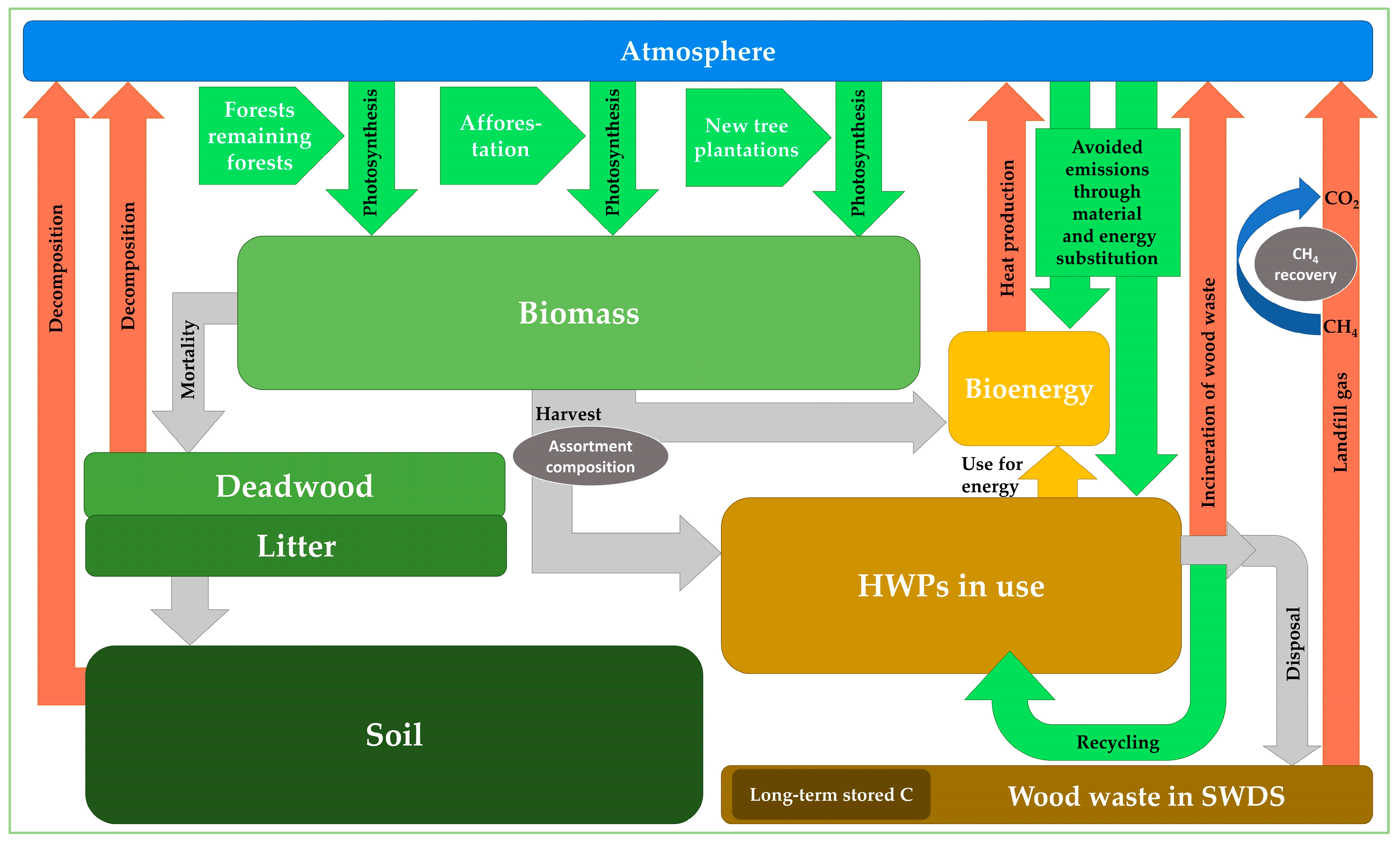

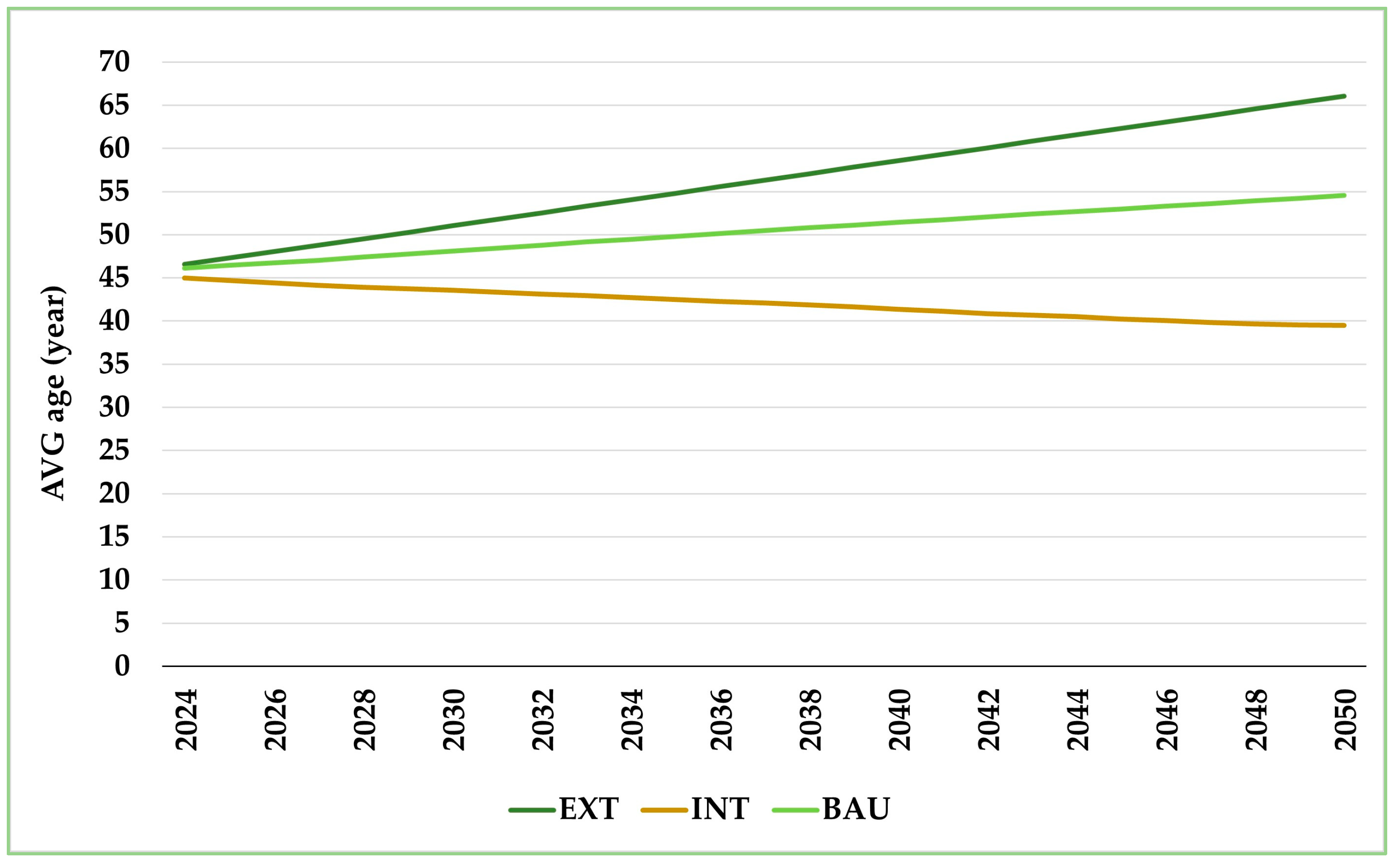
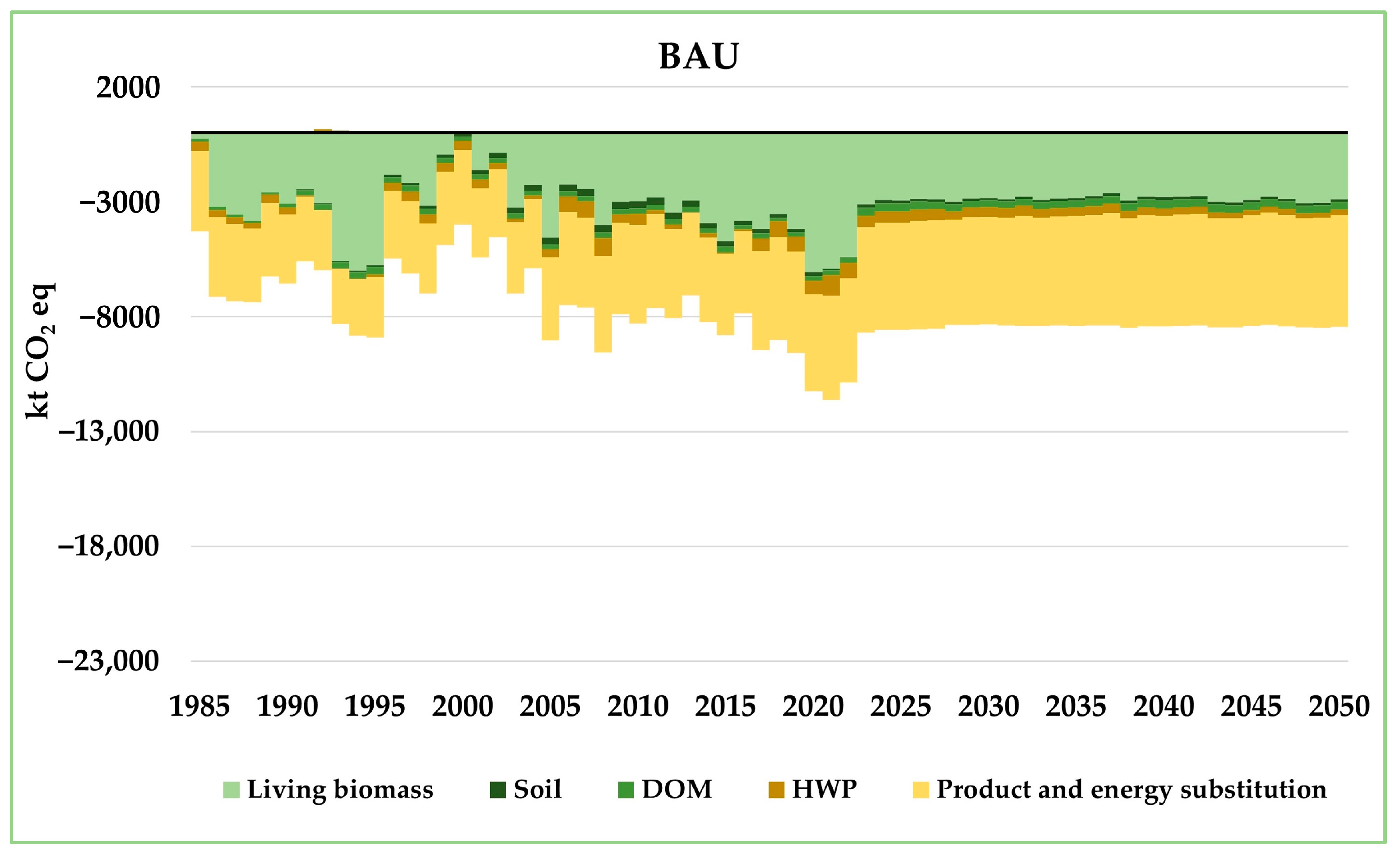

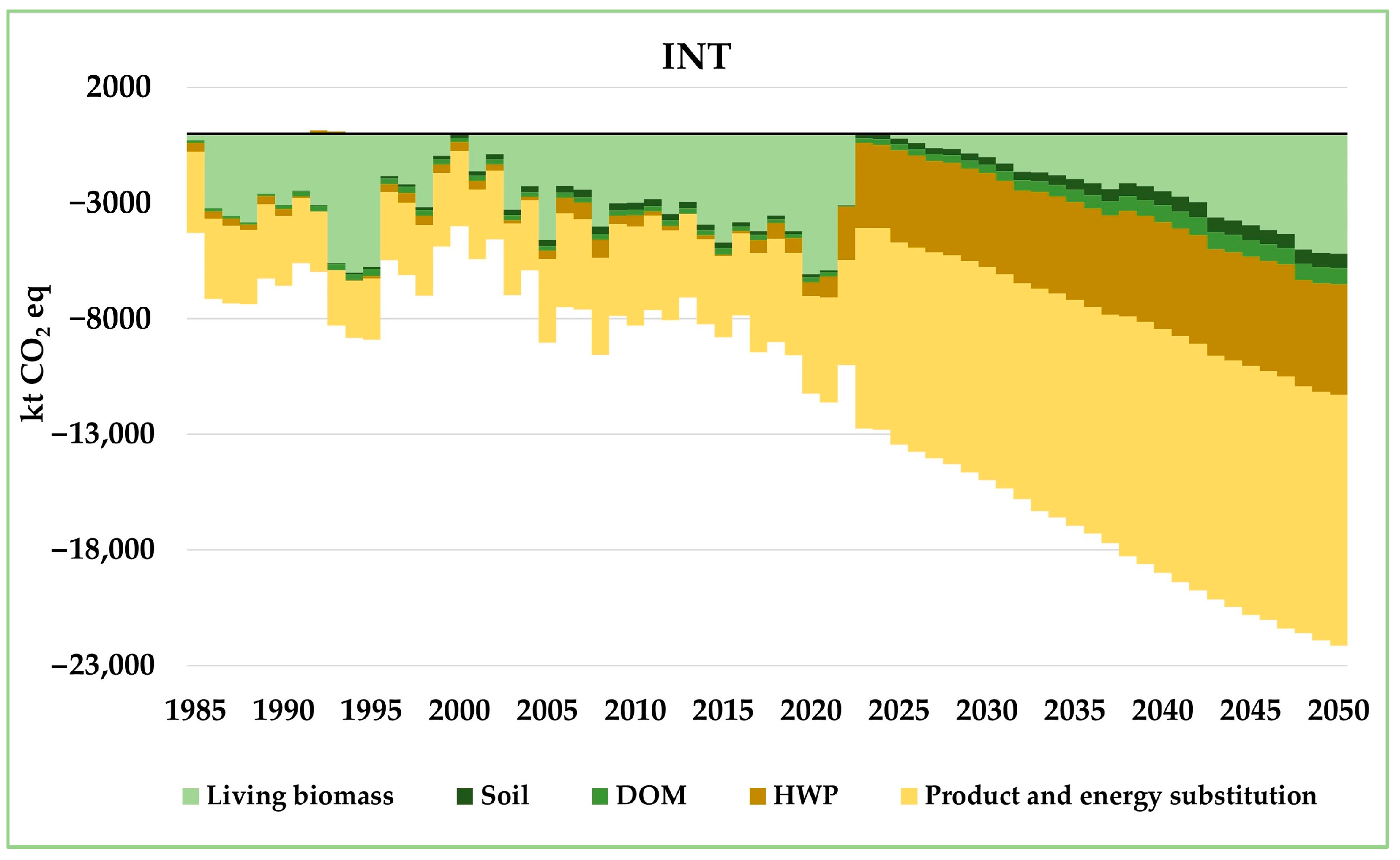
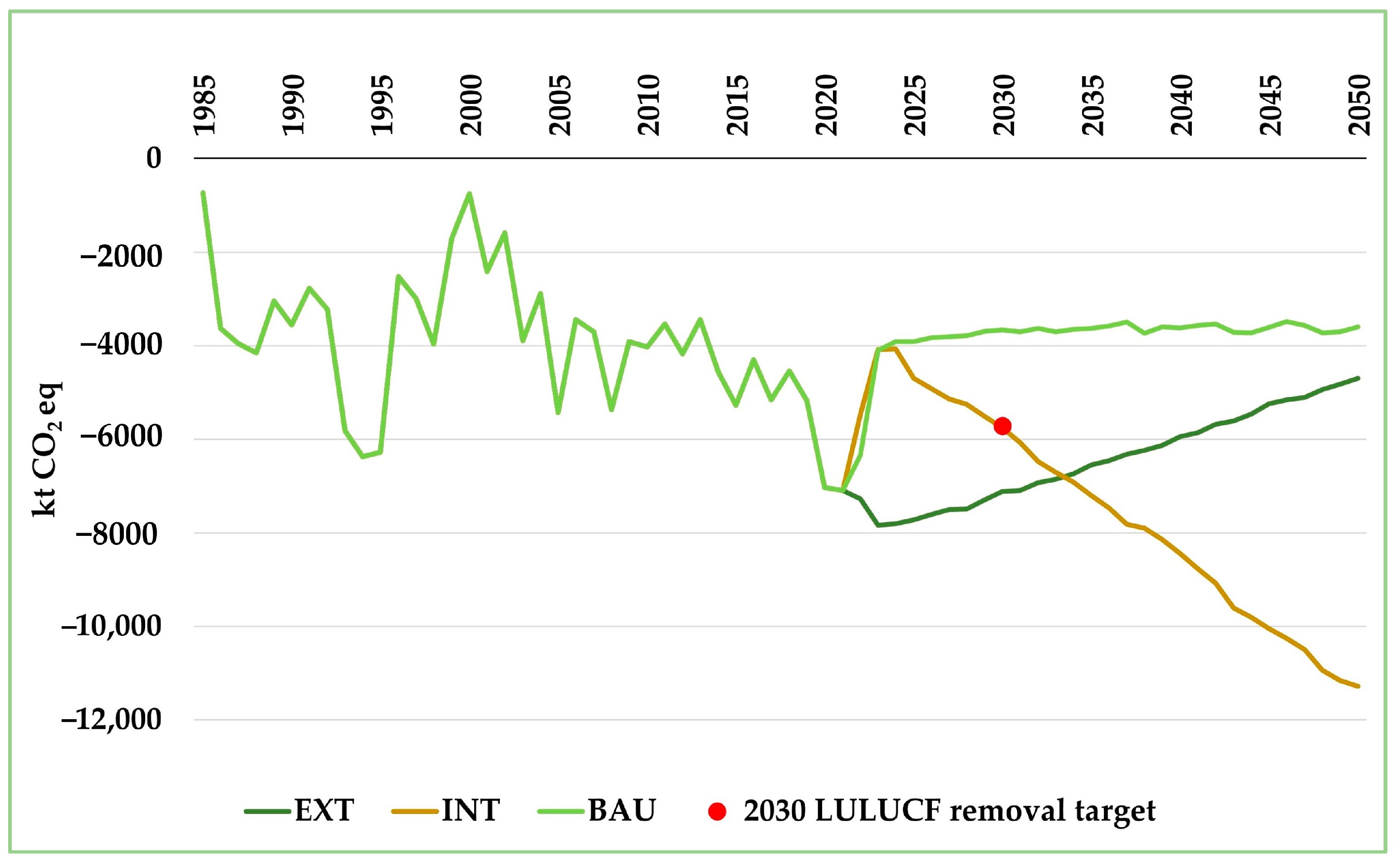
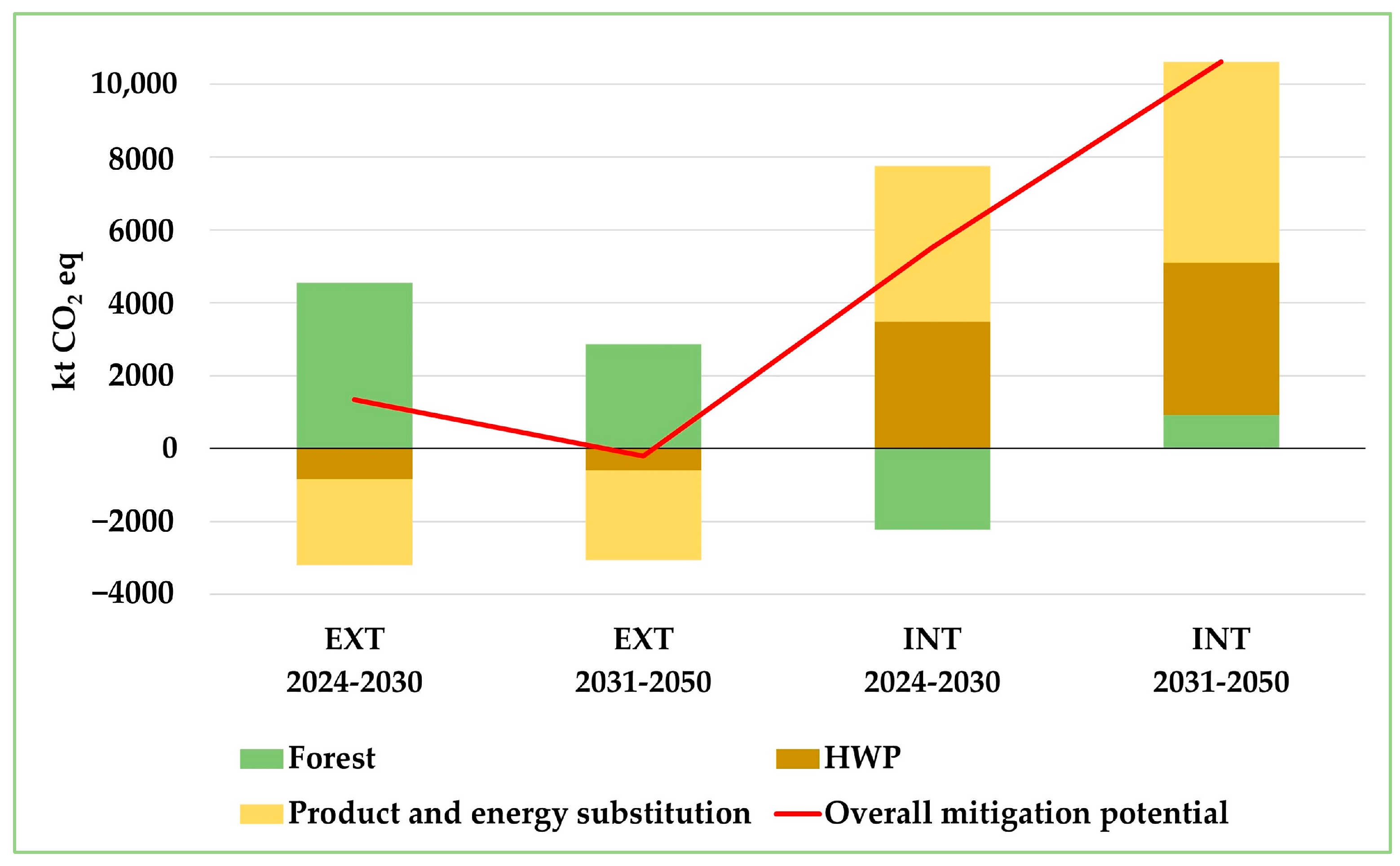
| BAU, 2050 | EXT, 2050 | INT, 2050 | |
|---|---|---|---|
| HWP Production | Average of the Last Five Historic Years | Half of the Last Five Historic Years | Increased Production Due to Increased Harvest and Increased Industrial Wood Assortment |
| Half-life sawnwood | 35 | 35 | 50 |
| Half-life wood panels | 25 | 25 | 35 |
| Half-life paper and paperboard | 2 | 2 | 2 |
| Landfilled wood % | 6 | 6 | 2 |
| Landfilled paper % | 10 | 10 | 2 |
| Recycled sawnwood % | 25 | 25 | 60 |
| Recycled wood panel % | 25 | 25 | 60 |
| Recycled paper and paperboard % | 71 | 71 | 90 |
| Methane recovery % | 7 | 7 | 60 |
| Substitution factor for wood products | 1.2 | 1.2 | 1.2 |
| Substitution factor for bioenergy | 0.67 | 0.67 | 0.67 |
| Oaks | Turkey Oak | Beech | Hornbeam | Black Locust | Other Hard Broadleaved | Hybrid Poplars | Indigenous Poplars | Willows | Other Soft Broadleaved | Pines | |
|---|---|---|---|---|---|---|---|---|---|---|---|
| BAU and EXT | |||||||||||
| Sawlog | 25% | 2% | 23% | 2% | 10% | 10% | 55% | 38% | 11% | 20% | 26% |
| Pulpwood for boards | 6% | 4% | 16% | 10% | 10% | 8% | 31% | 23% | 54% | 14% | 39% |
| Pulpwood for paper | 0% | 1% | 1% | 0% | 0% | 0% | 5% | 20% | 2% | 1% | 21% |
| Firewood | 69% | 93% | 59% | 88% | 80% | 82% | 8% | 18% | 33% | 65% | 14% |
| INT | |||||||||||
| Sawlog | 50% | 40% | 40% | 20% | 40% | 30% | 50% | 50% | 20% | 40% | 40% |
| Pulpwood for boards | 20% | 20% | 30% | 30% | 10% | 30% | 40% | 30% | 60% | 30% | 40% |
| Pulpwood for paper | 5% | 5% | 5% | 5% | 0% | 5% | 5% | 5% | 5% | 5% | 10% |
| Firewood | 25% | 35% | 25% | 45% | 50% | 35% | 5% | 15% | 15% | 25% | 10% |
Disclaimer/Publisher’s Note: The statements, opinions and data contained in all publications are solely those of the individual author(s) and contributor(s) and not of MDPI and/or the editor(s). MDPI and/or the editor(s) disclaim responsibility for any injury to people or property resulting from any ideas, methods, instructions or products referred to in the content. |
© 2024 by the authors. Licensee MDPI, Basel, Switzerland. This article is an open access article distributed under the terms and conditions of the Creative Commons Attribution (CC BY) license (https://creativecommons.org/licenses/by/4.0/).
Share and Cite
Borovics, A.; Király, É.; Kottek, P. Projection of the Carbon Balance of the Hungarian Forestry and Wood Industry Sector Using the Forest Industry Carbon Model. Forests 2024, 15, 600. https://doi.org/10.3390/f15040600
Borovics A, Király É, Kottek P. Projection of the Carbon Balance of the Hungarian Forestry and Wood Industry Sector Using the Forest Industry Carbon Model. Forests. 2024; 15(4):600. https://doi.org/10.3390/f15040600
Chicago/Turabian StyleBorovics, Attila, Éva Király, and Péter Kottek. 2024. "Projection of the Carbon Balance of the Hungarian Forestry and Wood Industry Sector Using the Forest Industry Carbon Model" Forests 15, no. 4: 600. https://doi.org/10.3390/f15040600
APA StyleBorovics, A., Király, É., & Kottek, P. (2024). Projection of the Carbon Balance of the Hungarian Forestry and Wood Industry Sector Using the Forest Industry Carbon Model. Forests, 15(4), 600. https://doi.org/10.3390/f15040600







